|
Posted by CO on
10-16-2007
|
Hello Romy and others,
Ive been away for a long time taking care of my health but i'm back with renewed interest. I am moving to a new house in the future and have plans for a dedicated music room (and an occasional movie) The space is however much smaller than my living is now so i'm a little concerned about the attainable sound quality there, mainly in the area of quietness (sound not hanging too long) and imaging. I would appreciate any pointers or possible problems you might see.
The room must be enlarged a bit to make room for enough distance between the speakers (this is the green area) I thought i might as well make the room symmetrical while in the process. The walls are concrete or brick btw.
The main problem i have with setup is the close proximity to the 45 egree walls and that this angle might introduce some kind of secondary image. I will need to damp the first reflections here anyhow so i might as well put the damping a bit around the corner.
I estimate the first reflextions against the sidewalls will be arriving 8,7 ms later. If i understand correctly as long as its more than about 5ms it won't effect imaging. There is also 'no' reflection of the right speaker on the right side wall this way. This may not be a good thing but a can always add a diffuser/reflector here if necessary. Exact placement of the speakers will remain te be seen ofcourse.
I also have the possibilty to make the room even bigger (violet area) but i loose a piece of closet space and it is alot more work.
I'm wondering how much positive ? influence this will have. A negative is that the room will become almost square.
I would rotate the speakers to the left side for more equal loading if i did it this way.
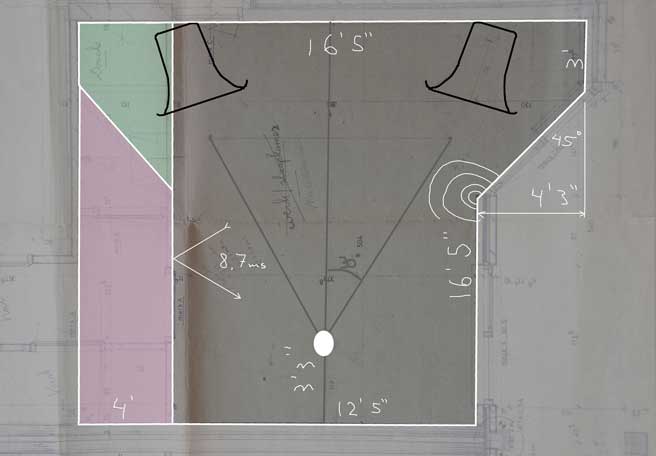
As soon as i have this stage pinned down i'm going to start thinking about a new set of horns. My first attempts were promising.
Collin
|
|
|
|
Posted by jessie.dazzle on
10-16-2007
|
Hello Collin,
Others may disagree, but my first reaction would be to give up the closet space and hang your clothes or store your items on open racks, covering the racks with a thick velour curtain; together this will make a nice diffuser/absorber, and will be more like only 2' deep on each side. (Costco sells some really well made big heavy wire racks with wheels that can be adapted for clothes if necessary... 70 bux each... All my clothes are hung on them).
Or, better yet... Use the covered shelves to treat the next problem, which is the proximity of your head to the rear wall. You could place the storage racks with curtains behind your head to eat up the reflected sound, leaving the sides open. This might be enough to eliminate the issues that come from having a square room. (If you use rolling shelves, you could try either side or rear positioning).
I once had a situation with the rear wall right behind my head... Treating that wall with a serious dose of anechoic foam took care of any reflected sound issues.
With the open rack solution you may find that you gain in the usability of your storage space, as it would likely end up easier to access.
The economy of this solution (you shouldn't have to buy additional wall treatment) will somewhat offset the cost of knocking out the closets.
jd*
|
|
|
|
Posted by Romy the Cat on
10-16-2007
|
Hellow, Collin
I am glad that you feel well. I do not think that I might be useful for this thread:
1) I do not believe that the subject of room acrostic and speaker placement might be viewed remotely
2) I generally do not believe in dedicated listening rooms, accept the special cases.
Rgs, Romy the Cat
|
|
|
|
Posted by Ronnie on
10-17-2007
|
Hi Collin,
The first thing my eye caught was the speaker-listener-speaker triangle with 60 degree opening on the listener side.
I think this is a very arbitrary number, and that you may find your ears will prefer a narrower angle.
I very consistently place myself where that angle is 46 degrees.
That said, I have no idea where your speakers will want to stand in relation to the room boundaries.
|
|
|
|
Posted by CO on
10-17-2007
|
|
Yes, i was already thinking the area behind me will need to be treated against reflections because i'm too close.
I have enough closet space so I’d like to solve it a bit nicer looking than a storage racks.
I'd still rather not use the violet area if it does not bring the rewards.
I dont have much damping in my room now because the room is so big and diffuse. I like the way it sounds. I think all these reflections are helping the sound alot. The new room wont let me do it this way..
I dont want to make one side extremely dead sounding as these reflections are very beneficial as long as they are not too early.
The ceiling will probably need some sails as well. Collin
|
|
|
|
Posted by CO on
10-17-2007
|
|
Romy,
I value your input so don’t pull out so quickly.. I was expecting your reaction though.
I,m not the 'typical Audio Moron' type, just planning ahead of time because remodeling is involved.
Imagine YOU were forced to move into this room with your gear…. You must have an opinion.
Of course I will try positioning extensively when I move in but you must agree I need to make some more room in this smallish room and some BIG horns.
The reason for a dedicated listening room is because I cannot force my family to follow my listening schedule. I have done this for years but it’s not optimal and its always a mess when I’m adjusting and changing the setup which is not very pleasant for the eyes. Collin
|
|
|
|
Posted by CO on
10-17-2007
|
|
I have found that with horns i can go much farther regarding angle and create a big image while retaining a solid center image and depth. The absence of early first reflections has alot to do with this phenomenon. I might not go that far in this room but I’d like to keep the possibility open. Collin
|
|
|
|
Posted by Romy the Cat on
10-17-2007
|
Collin,
I do not know why you guys dive so fast into self-Moronism rebattling – it was absolutely not my thoughts. The escaping from family is one of the “permitted” reasons to built dedicated listening room. What you do: planning ahead is perfectly normal and anyone would o the same. However I do not know how useful other might be in this ceremony.
A year or so ago James Op.9 had a thread “Barn Conversion” (look for “related reading” atop or at bottom of the page) where he did the same but he did it in a very intelligent way from my point of view. He did not care about the geometry but rather about the relation of the specifics of different acoustic system solution in regards with the specifics of his real estate. I think it is kosher direction to think – to relate space with AC topology that will be using the space. However, to look at a room’s demands and capacity abstractedly, without knowing the specifics of acoustic system that will be loading the room I feel is worthless thing to do. Well, perhaps not worthless but at least I feel it is the subject where any external advise would have little applicability.
Rgs, Romy the caT
|
|
|
|
Posted by CO on
10-17-2007
|
|
I thought my 30 degree notes might cause you to qualify me in that direction 
Yes i just found that thread. I however do not have much freedom to do a lot of rebuilding like he does, i wish i did.
The specific acoustic system will be a low cost probably 3 way straight horn system + subs like in my thread from a while back. Regards, Collin
|
|
|
|
Posted by Romy the Cat on
10-17-2007
|
Collin,
If they were straight horns then I would keep them further from the walls, in fact any speaker should be kept at least 3’-5’ from the walls to let “imaging to breathe”. I do not know what horns you have and what LF sections you will be using. One of the greatest accomplishments of this site that no one care or even know what audio equipment people use and the specifics are usually brought up in case of a given necessity. So, if you wish explain in details what acoustic system it will be and I think it would make more sense to ask what others think about your room. Still, I believe whatever I or anybody else might say it should NOT be a motivation for you as your own recognition of performance of your specific acoustic system in your room is the only objective factor. I do not mean to be difficult but I know that all those “long distance acoustic advisements” are usually bogus, including those that might came from me…
Rgs, Romy the caT
|
|
|
|
Posted by CO on
10-17-2007
|
The horn mouth will be 3-4 foot from the wall but you are right the MF/HF will be closer if i dont delay them so i can bring them out from the wall. If i line them up purely acousticly then they will move forward at least two more feet which puts the sound source at about 13.5 feet / 4m (diafragm) away from me. Not much but still enough for a quality playback i think.
It has quite a few negatives for my first room preference though...
- The angled side walls are very close to the speakers like this.
- I must walk between the speakers and around the back to go to the garden.
- The movie screen will be forced to go above the speakers, like sitting in the front wor of the theater instead of IMAX
This has got me thinking about knokking out some more walls (although i will be using a digital crossover for now)
Thanks to all the long distance advice givers.
Collin
|
|
|
|
Posted by RF at Ona on
10-18-2007
|
|
Collin,
I would suggest that you abandon the idea of placing your speakers against the back wall with that reflecting/diffracting angle in front of the speaker(s). Such a structural intrusion would not be kind to the polar radiation pattern of the loudspeaker-room system. It is not just a matter of the reflections which would reach the listener but the acoustical environment of the loudspeakers would be a mess. You might want to look at Roy Allison's work on the effects of room acoustics on loudspeaker linearity in this regard.
It is far better for that angle to be behind the speakers or the listener. Changing the room structure to create a similar angle on the left side doesn't solve the problem. It's rather like breaking your left arm after you've broken your right for reasons of symmetry. Nor do I think the added space would help much acoustically or visually.
I have had a little experience placing speakers in odd rooms. I lived in a number of studios and small apartments in Manhattan with challenging layouts, particularly during my student years. Some of my more successful placements were along the LONG side instead of the short side of a room. I've had living rooms so elongated that it was the only practical way and I have generally liked the results. I was using, at the time, planar and box speakers - not horns.
My experience with square rooms has never been good and I would avoid expensive alterations from a smaller rectangular to a slightly larger square room unless the placement problems were proven to be vexing.
FIRST DIAGRAM, a conservative approach:
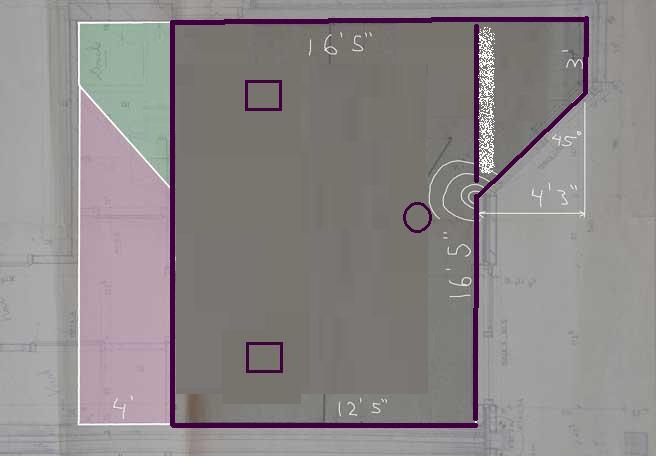
In the first drawing, I suggest a simple sidewall placement (black outline). A non-structural barrier such as tall shelving or cabinetry (white speckle) could be used to tame the odd angled alcove. You could enlarge the room as you indicated but it would take the room toward square - classic trade off between worsening the standing wave colorations but improving the placement issues (more coherent speaker, better early reflection characteristics).
SECOND DIAGRAM, a hexagonal model:
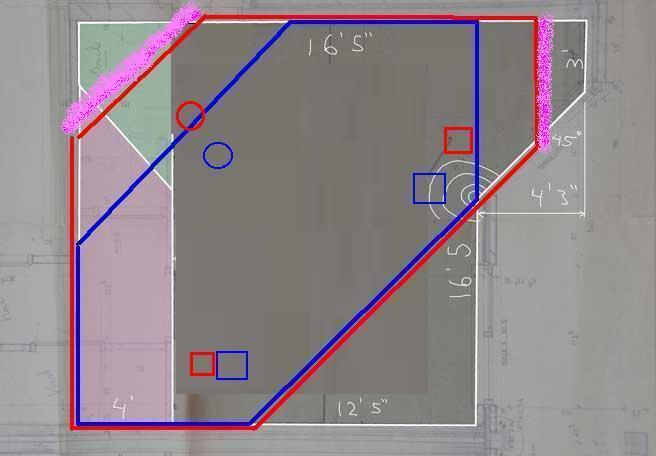
In the second diagram, I show an enlarged room but with a prototypical wide hexagonal room with the speakers placed along the wide side - now nearly diagonal to the original room (blue outline). The hexagonal geometry is nice acoustically. It is symmetric and has improved standing wave characteristics. You can stretch the hexagonal shape to use more of the room (red outline). Note that the short room sides (pink speckle) need not be structural, shelving would do.
The speaker placement is near to the enlarged room's main diagonal and has the effect of both visually and acoustically widening the room.
Try this visual test in a room - stand on the diagonal facing the far corner. Notice how wide the room looks compared with facing a sidewall directly. That room diagonal, with the corners of the room in the visual peripheral field, is a great asset to exploit.
THIRD DIAGRAM, Enlarged room - Diagonal Placement:
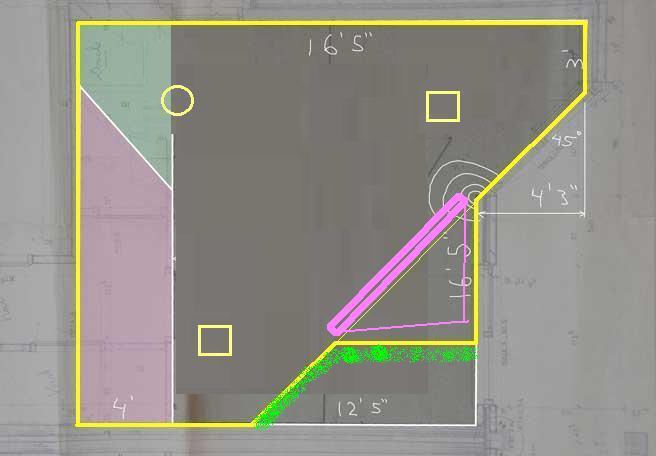
In the final diagram, I show a diagonal placement using nearly all the enlarged room (yellow outline). The hexagonal has been stretched to a nearly triangular pentagon. I must say that I have limited experience with such a triangular room shape but it has things to recommend it. In particular you have wide visual and acoustic space without structural interference between the speakers and the listener. There should not be a standing wave problem similar to a square room because the equal length sides are not parallel and there is some irregularity to the shape.
In my diagram, I show the wall behind the speakers with a small alcove for your television (in pink), if it needs depth. The short walls (with green speckle) are non-structural and again could be made with tall shelving or cabinetry.
Because this layout can be tried most directly after the room is fully enlarged, I would probably try it first and possibly work toward a more ideal shape with furniture and acoustical treatments or barriers if needed. However I wanted to show a logical progression from a superior (but smaller) hexagonal geometry to this more practical one.
Best of luck - I hope it all turns out well,
Robert
PS: Where I mention tall shelving or cabinetry isolating a space or acting as a non-structural wall, I am referring to a full floor-to-ceiling acoustical barrier or to filling the space (packed storage). You want to avoid creating a resonant cavity or Helmholtz resonator out of these room pockets.
|
|
|
|
Posted by CO on
10-18-2007
|
|
Wow Robert thanks for all your ideas.
I happen to be using a diagonal placement now as well and I really like it. I thought I was the only one who knew this ! 
I did not think this new room would be big enough to do it so I threw the idea out. I only recently thought about enlarging the room over the full length. It looks like this will be my best option.
The diagonal placement is great because it excites the room modes more distributed and lower in level + the side walls are relatively far away. Thanks for opening my ears again ! Also thanks for warning me about the sidewall problem. I was also a little worried about the sidewall problem but thought I should be able to fix it with damping. That will probably not be optimal…
I have windows behind the screen in your last setup that I can still use so that would be my best option.
Why do you consider the hexagonal placement the best? Because of the flat wall behind the listener? (less cavities ?)
If the ‘closet’ behind the right speaker would be open near the windows do you think there would be a cavity resonance? I could make a door there as well I guess.
The only problem I’m still thinking about is I’m still fairly close to the speakers If I acousticly time alight them and want to keep them away from the back wall.
Regards, Collin
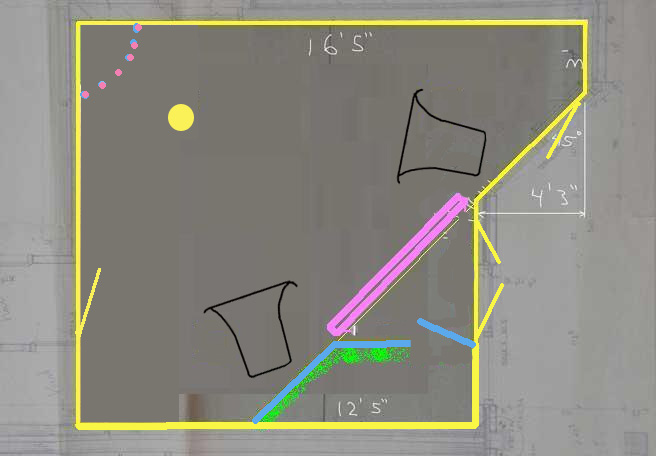
|
|
|
|
Posted by CO on
10-18-2007
|
May i ask how far you are from the front of the upper bass horn (on axis) You also mention being in a 'small' room ?
Rgs, Collin
|
|
|
|
Posted by Romy the Cat on
10-18-2007
|
My minimal distance between front of the upper bass horn and listening position is irrelevant as I set the proximity not according the upperbass but according a vertical shifting of HF image. Under a normal circumstances I might be as liitle as ~7.5” from MF channel.
Regarding the “RF at Ona” comments. All his point are very valid and very much agree with them, but still - they are juts generalizations and in very many instances they all might be offset by the specifics of given acoustic system and the given room idiosyncrasy. When you load a room with speakers (and particularly it is true for horns) , begin to measure the room and to listen the room then it is always some negative or positive discovery awaiting you and you begin to make “moves” that mostly offset your initial intentions.
Therefore I, as I said many time before: any serious large horn inhalation should be custom imbedded into a given room, and to do so the behavior of the room should be learned. I do not think that the learning is possible “long distance”.
Rgs, Romy the caT
|
|
|
|
Posted by Paul S on
10-18-2007
|
Collin, I think you just got some excellent ideas from Robert, including practical use options for available square footage, and there is maybe more to Romy's responses so far than yields to casual inquiry.
I haven't used horns for years, but I know that there are very few horn systems I would want to be stuck that close to or shut in a room that small with, no matter which of those shapes you chose.
From what I can see you will probably have your work cut out for you with any of the options shown, depending on your budget, expectations, preferences, etc, etc. But I'm sure you are aware that your present speakers/system may need modification to work properly in the available space. In any case, for sure it isn't just about the space.
As a builder, I can say FWIW that a solid concrete room generally benefits from some serious resonance control/damping efforts, and any framed walls can "help" with this if some thought is put into wall coverings, furniture, etc. Likewise with shelves, screens, etc., they help to break up what can become problematic energy and/or undesirable augmentation/cancellation effects that are almost impossible to predict from models.
Of course, floor and ceiling types and materials figure in, as well, and who can say what you will start with, really, let alone what you are working with or what you are working toward?
Best regards,
Paul S
|
|
|
|
Posted by RF at Ona on
10-20-2007
|
|
Collin,
I am pleased that you found my suggestions worthwhile.
I approached the issue of your music room with two questions in mind:
1- How to avoid the structural angle from interfering with the sound
2- Would an enlarged room be worthwhile?
Exploiting the basic rectangular shape of your original room with speaker placement by the long side deals with the first.
Although enlarging the room creates a less desirable square space, one can make virtue of necessity with a diagonal placement along the extended 45-degree angled wall.
The diagonal placement approach works more naturally in a square room since the listener corner is centered. Conversely, diagonal placements are awkward in rectangular rooms because the opposing corner where the listener is placed does not lie between the speakers but off to one side. So by enlarging and squaring your room one gains the option of diagonal placement. Also since part of the room has a structural intrusion, you don't lose all that much space with this approach. I concluded that an enlarged room would be quite worthwhile with this approach.
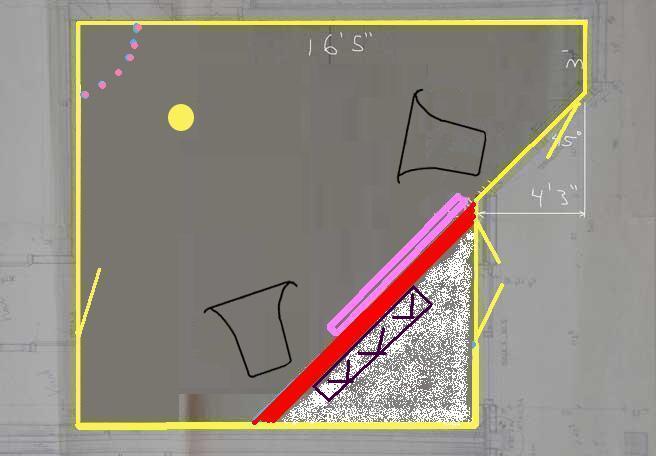
I basically intended that the angled wall extension behind the speakers would be an architectural wall (heavy red line in the diagram) acoustically separating the small triangular space (white speckle). However I showed how the space could be tested with moveable barriers like shelving, but my original concept and continued recommendation is to eventually make that wall structural. You might possibly reuse the brick and concrete you are removing to enlarge the room in building this extension.
Since your TV is flat and doesn't need space behind, all of the triangular space could be used for something. I would tend to use some of it for an infinite baffle (or very large enclosure) woofer array. Well done, an IB woofer can be a very good approach to reproducing the bottom octave as well as useful for your video sound effects. Why not take advantage of your dedicated music room in this way? Of course you may have other plans that take into account the windows and doors - compromises may be in order.
Regarding your other questions,
a) There is nothing special about the wide hexagon shape. It is symmetrical and so might support good imaging and would have reasonable standing wave characteristics. I simply used it as the kernel of an idea of what kind of useful acoustic space your enlarged room would support and worked from there. Had your room naturally fitted a rectangular or wide octagonal geometry I would have started from one of those basically useful shapes.
b) If a small space is acoustically sealed (isolated) from the main listening room, you don't have to worry about it. But you don't want to partially block a space, as the constrained air in the cavity would be resonant. This phenomenon is the basis for a vented box/bass reflex speaker where, of course, the parameters are adjusted for a useful resonance. Better to leave the space wide open than partially enclosed (partially filled, reducing air volume is OK). Think of the space as filled by ricocheting ping-pong balls. If it tends to trap the balls it is bad, if the balls can escape easily it is better.
You do want to worry about thin panel doors, like closet doors, and windows in the main listening room. I am no acoustic purist in these matters however. I think large windows giving a lovely view are a blessing and as good a reason to pay real property taxes as any. The practicalities of family life and the courtesies of social living also must be observed. I have spent many hours listening with headphones with this in mind.
Finally, let me add a personal point of view. If you walk into a room and you are not really aware of its acoustics - it is probably a good room (good staring point) for an audio system and that should be your basic first goal in furnishing the room. If you sense that it is highly echoic or that it is sounds unnaturally dead from aggressive acoustic treatment or if you have trouble with hearing a normal conversation in it you have more work to do. Although our senses accommodate to the environment, I have never liked long-term listening in a room with a basically unpleasant or contrived acoustic no matter what advantages the acoustical treatments have on the audio system.
Best wishes on your project. May the results exceed the anticipation,
Robert
|
|
|
|
Posted by Romy the Cat on
10-20-2007
|
 RF at Ona wrote: RF at Ona wrote: | | Finally, let me add a personal point of view. If you walk into a room and you are not really aware of its acoustics - it is probably a good room … |
|
It is not my observation. When you walk into a good room it clearly heard as a different acoustic event. It is very pleasant to be and very pleasant to talk in a good room. I am always aware of its acoustics in good room. Also a good room for whatever reasons feel “cooler” for me and with high humidity…
 RF at Ona wrote: RF at Ona wrote: | | I have never liked long-term listening in a room … |
|
I never like any long-term listening in a any dedicated room. Music should sound where a person lives and if I need to lock myself in a secluded dedicated room then it become too contrived and I do not feel comfortable… I usealsy feel very board in dedicated rooms...
|
|
|
|
Posted by clarkjohnsen on
10-20-2007
|
My single additional thought (you've received some excellent advice already) is to beware the semi-cubbyholes in which the speakers are placed. Those will become partial Helmholtz resonators and therefore do odd things bass-wise. Amelioratives must be considered!
clark
|
|
|
|
Posted by CO on
10-21-2007
|
Thanks for your further thoughts and explanations Robert, Romy and others.
It looks like the full room enlargement will be my choise. Dont know i want to block the windows though. Maybe i can solve this by making a glass window behind the screen.. I will let this idea rest in the back of my head for now.
A place for the subs is next on the agenda. In the area behind the screen is quite a large volume for a few big woofers but it must be structurally quite strong to not have any vibrations that influence the sound. Also to use the this area i would need an airtight door here as well. If i generate 100dB sound on my side there will be maybe 110 dB on the other side of the wall. I could attach my couch to the wall with an extension pole 
I think a few sealed boxes will be more flexible but building them in the wall sounds very tempting. Quality wise i believe an "infinite baffle" aproach should be one of the best (although i have never heard one) because of the lack of the back wave hitting the cone again.
Regards,
Collin
|
|